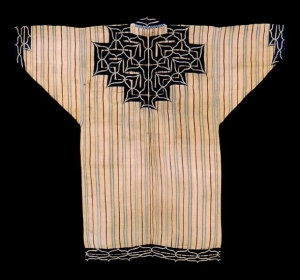The Ainu of the Sakhalin Islands also decorated their garments, but these were originally made from fish skins, rather than a woven material. They decorated their 'fish garments' (cep-ur) by applying other fish skins, basically to fill up the holes left by the fins of the fish. They needed in all some forty fish to make a garment. The pattern of decoration and its location are different from those associated with the woven garments of the Hokkaido Ainu.
But the Sakhalin Ainu later also had clothes made of nettle. These were called tetarpe. They were decorated in the same manner as the garments of the Hokkaido Ainu. Cotton thread, available through trade with Japan, was increasingly used among the Ainu, from the late eighteenth century onwards. More costly silk thread was also used.
With the wide-spread introduction of cotton, the Ainu on Hokkaidu and beyond started to make complete robes (called chikarkarpe or 'things we embroider') that were decorated with appliqué (mostly with black or indigo fabrics) and embroidery. Their symmetrical spiral motifs were made by stitching a thin line parallel to wider lines. The patterns are geometric, but organic in nature, with a strong sense of movement and emotion, with dynamic swirls, s-curves, lozenges and ovals, all of which provided with barbs to symbolically prevent evil from entering the body of the wearer. On kaparamip ('thin clothes'), the (often white) appliqué patch had a design cut out to show the darker ground cloth (reverse appliqué). Other cotton Ainu garments include the ruunpe ('things which have a route') and cijiri ('things we embroidered').
Appliqué designs and embroidery stitches were passed down from mother to daughter, but they nearly became extinct from the late 1890's through the 1930's, when most of Ainu culture was 'Japanised' by the central government. Some traditional clothes were only seen at sights where Ainu were 'displayed' as tourist attractions. The tradition of Ainu clothing was almost lost until a revival of interest in Ainu culture in the 1980's and 1990's. Women such as the Ainu poet Shizue Ukaji (1933), as well as Eiko Ota, Kayoko Nishida, Sanae Ueda, Nobuko Tsuda, Yasuko Uetake, began studying old photographs, museum collections, as well as talking with elderly Ainu women (huci) in order to recreate traditional designs and stitches. They then started to teach classes, publish books and hold exhibitions and lectures about Ainu embroidery and garments in order to spread what they had learned. Shizue Ukaji has also developed her own art form, consisting of embroidering Ainu folk tales on cloth, which she calls kofu-e, or 'old cloth pictures.'
Nobuko Tsuda, a curator at the Hokkaido Ainu Centre, has researched Ainu women’s sewing, basketry and braid work. She has successfully reproduced traditional Ainu pattern composition methods, which involve folding a piece of cotton cloth both vertically and horizontally into equal parts, sewing the opened cloth onto the ground cloth, and then hand embroidering each section with traditional designs.
See also he TRC Needles entry on the Ainu Museum, Hokkaido, Japan.
Digital and other sources:
- The Foundation for Research and Promotion of Ainu Culture "FRPAC" (2003). Ainu kara no messeji: Mono zukuri to kokoro [Message from the Ainu: Craft and spirit]. Sapporo: The Foundation for Research and Promotion of Ainu Culture "FRPAC".
- The Foundation for Research and Promotion of Ainu Culture "FRPAC" and Hokkaido Museum of Modern Art (2006). Ainu mon-yo no bi: Sen no inochi, iki zuku katachi [The beauty of Ainu design: The soul of lines, breathing shapes]. Sapporo: The Foundation for Research and Promotion of Ainu Culture "FRPAC".
- The Foundation for Research and Promotion of Ainu Culture "FRPAC" (2008). Ainu Collections - University of Pennsylvania Museum of Archeology and Anthropology Hiram Hiller Collection. Sapporo: The Foundation for Research and Promotion of Ainu Culture "FRPAC".
- http://frpac.or.jp/index.html.
Digital source of illustration (retrieved 5th July 2016).
NK and SA

